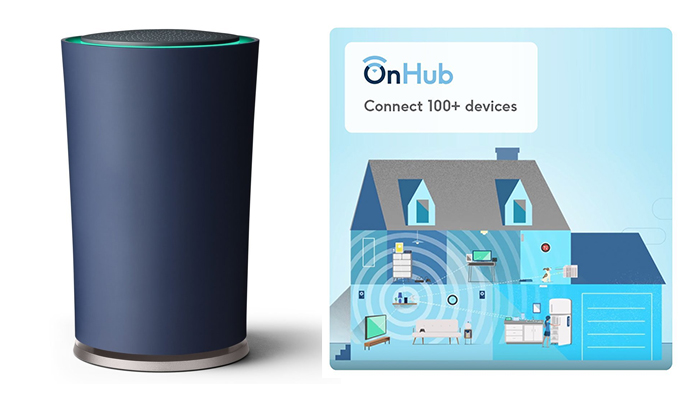If you’re looking for a router that mixes smart design with simple features and solid performance, Google WiFi Router On Hub AC1900 is a solid choice. However, users who like to get their hands dirty may prefer the control and flexibility of more conventional products. For the rest of us, Google WiFi will likely eliminate some key pain points and provide an easy transition to the connected home.
Google officially enters the home Wi-Fi router arena. Co-developed with TP-Link, the On Hub AC1900 is a dual-band model with a sleek form factor that looks nothing like a traditional router. It contains more than a dozen antennas, is a cinch to install, and it uses a thoughtfully designed app to control certain network functions. The OnHub AC1900 is equipped with circuitry to control Zig Bee home automation devices and has a Bluetooth 4.0 radio, but neither of these features are enabled as of this writing. Moreover, it will only accommodate one wired LAN connection, and its lone USB port is reserved for recovery purposes.
The On Hub is an AC1900 router that can (theoretically) provide up to 600Mbps on the 2.4GHz band and up to 1,300Mbps on the 5GHz band. Under the hood are a 1.4GHz dual-core processor, 4GB of eMMC flash storage (for software updates), and 1GB of DDR3 memory. There are also six 2.4GHz antennas and six 5GHz antennas arranged in a circular pattern for maximum coverage in all directions, a reflector antenna that boosts signal strength, and a congestion-sensing radio that continually polls wireless activity and changes channels to increase performance. The OnHub is also equipped with Zig Bee and Bluetooth antennas, but neither are currently enabled. Google says it plans to add support for both in the future, but does not provide a timeframe.
Design
 The Google OnHub AC1900 developed in tandem with TP-Link, is easily one of the best-looking routers ever developed. Unlike countless other routers to be found on store shelves, the OnHub comes with a sleek design that’s actually meant to be placed in a prominent position in the home – not tucked away in an office corner somewhere.
The Google OnHub AC1900 developed in tandem with TP-Link, is easily one of the best-looking routers ever developed. Unlike countless other routers to be found on store shelves, the OnHub comes with a sleek design that’s actually meant to be placed in a prominent position in the home – not tucked away in an office corner somewhere.
OnHub boasts a blue cylindrical case that can be taken off to reveal the device’s internals. At the bottom is a metal stand and at the top is a circular, grate-like cap. Underneath the hood, there are two Ethernet ports – one for WAN and another for LAN. There’s also a USB port and, according to Google, support for Bluetooth and Weave – the company’s home-automation platform. The On Hub’s design reflects the concept that Google is bringing to the table with the router: simplicity. Although there are no antennae in sight, the router is capable of pumping out both 2.4GHz and 5GHz networks without trouble. If design were the only metric by which I was judging the OnHub, it would perform exceedingly well.
Installation and Performance
Installing the OnHub couldn’t be easier, but you’ll have to have a valid Google account to do so. To start, download the app and sign in using your Google account username and password. Follow the on-screen instructions to plug in the router’s power and Ethernet cable, then get the router’s setup code and SSID from its base. Go to your mobile device’s Wi-Fi settings, connect to the router’s SSID, and return to the Google On app to name the router and create your network. Use your Wi-Fi settings to connect to the router, and you’re done. Google suggests putting the OnHub out in the open, preferably at eye level for optimal range, but most homeowners will be limited in their location choices unless their home is wired for Ethernet.
Google On App
Whereas most routers are managed via a Web-based interface, the OnHub AC1900 is managed using the free Google On app for iOS or Android and does not currently offer Web-based controls. The app is very easy to use and offers plenty of tips and explanations for its various settings. The main page displays an overview with a diagram of your connected devices. It alerts you to any issues and offers a brief explanation and a link to the Help Guide to resolve those issues. You can click on any device to see its IP address, MAC address, connection status, and upload and download history. You can also view real-time data usage for each device and assign traffic priority for 1-, 2-, or 4-hour periods.
Overview of the features of Google WI Fl Router
• Super fast Wi-Fi speeds up to 1900 mbps to help with smooth streaming, gaming and downloading
• Helps eliminate dead zones with 2.4GHz and 5GHz Bandl/2/3/4 Wi-Fi antenna-13, 2.4GHz Bluetooth antenna- 1 & 2.4GHz Zigbee antenna-1. Reliable coverage for most homes up to 2,500 square feet.
• Supports 100+ connected devices, so everyone can get on at once
• The companion Google On app makes setup simple and lets you to control your network from your smartphone
• Automatic security updates help keep your network safe.
• A separate guest network helps get friends online easily, and allows you to share devices, like your Chromecast, with them.
Should you buy it?
Google has designed the device to be accessible to beginners and those who want simplicity when setting up a home network. While it certainly delivers there. Anyone looking for a simple experience will like what they find in the On Hub AC1900, and if that’s combined with the quality of its experience, it’s hard not to choose it.
Pros
• Simple setup
• Modular design for better coverage
• Family-friendly control features
• Modern design
Cons
• No web interface
• Lacks some advanced features
• Only two cable ports
Conclusion
The Google On Hub AC1900 is designed for non-tech-savvy users looking for a quick and easy way to bring dual-band networking to the home, and in that respect, it succeeds. Its unique design lets you place it anywhere in the house (as long as you have a wired Ethernet connection there) and its user-friendly app makes it easy to set up and monitor your home Wi-Fi network.

